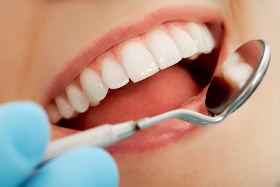 Since times when the Romans used urine for the purpose, teeth bleaching (teeth whitening) has been a consistent goal of mankind. Dental bleaching, teeth swabbing, tooth whitening and other similar phrases refer to one of several bleaching options for those with stained, yellow or otherwise blemished teeth. These dental bleaching choices include:
Since times when the Romans used urine for the purpose, teeth bleaching (teeth whitening) has been a consistent goal of mankind. Dental bleaching, teeth swabbing, tooth whitening and other similar phrases refer to one of several bleaching options for those with stained, yellow or otherwise blemished teeth. These dental bleaching choices include:
In-Office Teeth Bleaching
Superior teeth bleaching results can be obtained with an in-office whitening session. In most cases a protective coating is painted onto the gums. This decreases any chance of getting chemically burned from the process. Next, carbamide peroxide is applied to the surfaces of the teeth. This solution can be anywhere from 3 to 16 percent hydrogen peroxide.
If elected, a patient may also add in the service of light acceleration. Using either LED, halogen or plasma lighting, the dental professional intensifies the teeth bleaching process by exciting the peroxide atoms with light energy. Care is taken to never overheat the pulp of the tooth being treated. This technique is also commonly called “power bleaching” and/or “laser bleaching”.
When light acceleration is used, the protective agent for the gums is stronger, and the percentage of hydrogen peroxide in the bleaching agent goes up to between 25 and 38%. Patients stay under the light between 6 and 15 minutes. The entire process lasts between 30 minutes and an hour in most cases.
Internal Teeth Bleaching
Internal teeth bleaching techniques (also called “walking bleaching”) are used, many times, after a dental patient undergoes a root canal. The root canal procedure causes blood to flow into the pulp of certain teeth, leaving them discolored. Internal teeth bleaching involves:
Drilling a small entry hole into the pulp chamber of the tooth;
Cleaning the pulp chamber;
Filling the canal of the root with a substance that seals it;
Filling the pulp chamber with a hydrogen peroxide solution;
Sealing the hole up;
Replacing the solution as needed until the internal bleaching of the dentin layer is complete;
Of course, there are several non-office teeth bleaching products and techniques you can try too. These are generally not as effective as having the services performed professionally, however they can and do make appreciable improvements in appearance. Some of the more popular at-home teeth whitening products include:
- Teeth bleaching pens;
- Whitening strips & gels;
- Bleaching chewing gums and toothpastes;
- Home light bleaching kits;
And some people also utilize natural teeth whitening techniques like eating green apples, brushing with lemon juice, brushing with peroxide or baking soda and others. Care should always be used when attempting to bleach teeth at home. For instance, too much lemon juice, peroxide or baking powder can cause damage to the teeth and soft tissues of the mouth and throat. Choose your teeth bleaching method carefully and always consult your dental professional before making your choice.
